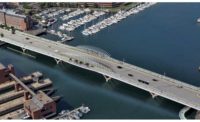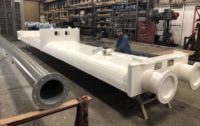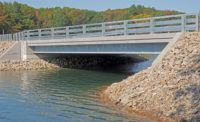Aging Infrastructure
Century-old Connecticut River Bridge Set for $500 Million Replacement
At risk of failure, span is an essential component of Amtrak’s Northeast Corridor

The more than century-old Connecticut River Bridge will be replaced with a more modern one.
Photo courtesy of Amtrak
Concerns about deterioration of the more than century-old Connecticut River Bridge and its risk of operational failure have prompted Amtrak to replace the span, in what will be an estimated $500-million project.
The oldest rolling lift bascule bridge between New Haven, Conn. and Boston on the north end of Amtrak’s Northeast Corridor “fails to open and close properly, which has led to cascading delays to rail and maritime traffic,” says Jason Abrams, Amtrak spokesperson. “Due to its age and deteriorated condition, the operational reliability of the existing bridge is at high risk.”
Replacement of the bridge is currently at 90% design and Amtrak is “working toward a 100% design to be submitted in the near future,” with plans to begin procuring a contractor in early 2023, according to the rail system's website. An environmental assessment and preliminary design have been completed and a National Environmental Policy Act review by the U.S. Environmenal Protection Agency is underway.
Construction is set to begin in the first quarter of fiscal year 2024, with completion expected by fiscal year 2029—about 68 months from notice to proceed, according to Abrams.
“The new bridge will improve the bridge’s functionality and serviceability to a useful life of 150 years, a far greater period than the current bridge’s 100-year useful life,” says Abrams, who notes that any train traveling between New Haven and Boston uses the bridge, “making it an essential component of Northeast Corridor travel, especially on the North End of the Corridor.”
The bridge includes an investment of $500 million from Amtrak, the Connecticut Dept. of Transportation (ConnDOT) and the Federal Railroad Administration, according to Amtrak. Amtrak and ConnDOT will provide 38% in matching funds, bringing the total to more than $100 million toward the project, which has received two grants of $65.2 million each, the first in 2020 and another in August from the Federal-State Partnership for State of Good Repair Program.
The project would replace the existing 107-year-old bridge that carries 56 trains across the bridge every weekday between Old Saybrook and Old Lyme, Conn, including 38 Amtrak trains, 12 ConnDOT trains and six Providence & Worcester trains, Abrams says.
Amtrak hired New York City-based engineering firm Hardesty & Hanover as a third-party consultant to design the new bridge. The lead designer will design “the off-line replacement of a two-track electrified bascule railroad bridge crossing a major tidal river with approximately 1500 ft of approach structure and nearly one mile of at-grade approach work,” H&H’s website says.
Project scope includes environmental permitting, project management of all design disciplines and multiple specialty subconsultants; topographic and bathymetric surveys and track design; geotechnical investigations and foundation design; civil design of approaches and approach retaining walls; right-of-way and easement determinations and utility investigations and engineering.
Installation of an electrified two-track with a moveable bridge will improve the bridge’s functionality and serviceability, Abrams says.
While the current lift span miter rails limits speeds to 45 mph, the new lift span will allow for 70 mph due to an improved miter rail design, Abrams says. “However, speed restrictions on the curves on either side of Connecticut River Bridge must be optimized where practicable to attain the most benefit possible from the bridge speed improvements.”
The original bridge “comprises a 1,564-ft-long two-track, open deck, electrified railroad bridge, “consisting of seven thru-truss spans, two- two-deck girder spans, and one 158-ft Scherzer-type rolling lift span,” the Hardesty & Hanover website notes. “In recent years, the draw span of the bridge has been operated approximately 3,700 times annually to accommodate navigation on the Connecticut River.”
The 457-mile main line of Amtrak’s Northeast Corridor from Boston to Washington, D.C. still includes many bridges and tunnels built during the Civil War and New Deal era, according to an October 2021 report by the rail system. If transportation agencies are unable to meet the corridor’s state-of-good-repair, this could “further impact service reliability and jeopardize the well-being of the Northeast region and the entire nation,” the report warns.




